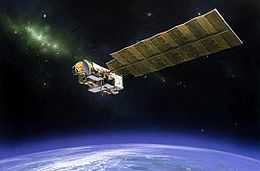Aura (satellite)
 Aura (EOS CH-1) | |
| Mission type | Earth Observation |
|---|---|
| Operator | NASA |
| COSPAR ID | 2004-026A |
| SATCAT № | 28376 |
| Website | http://aura.gsfc.nasa.gov/index.html |
| Spacecraft properties | |
| Launch mass | 2,970 kilograms (6,550 lb) |
| Power | 4.6 kW |
| Start of mission | |
| Launch date | July 15, 2004, 10:01:51 UTC |
| Rocket | Delta II 7920-10L |
| Launch site | Vandenberg SLC-2W |
| Orbital parameters | |
| Reference system | Geocentric |
| Regime | Sun-synchronous |
| Eccentricity | 0.0001111[1] |
| Perigee | 708 kilometers (440 mi)[1] |
| Apogee | 710 kilometers (440 mi)[1] |
| Inclination | 98.22 degrees[1] |
| Period | 98.83 minutes[1] |
| Epoch | 25 January 2015, 03:15:27 UTC[1] |

Aura (EOS CH-1) is a multi-national NASA scientific research satellite in orbit around the Earth, studying the Earth's ozone layer, air quality and climate. It is the third major component of the Earth Observing System (EOS) following on Terra (launched 1999) and Aqua (launched 2002). Aura follows on from the Upper Atmosphere Research Satellite (UARS).
The name "Aura" comes from the Latin word for air. The satellite was launched from Vandenberg Air Force Base on July 15, 2004, aboard a Delta II 7920-10L rocket.
The Aura spacecraft has a mass of about 1,765 kg. The body is 6.9 m long with the extended single solar panel about 15 m.
In formation, in a "train"
Aura flies in a sun-synchronous orbit, in formation with the "A Train", a collection of several other satellites:
all satellites having an equatorial crossing time at about 1:30 in the afternoon.
Mission
Aura carries four instruments for studies of atmospheric chemistry:
- HIRDLS — High Resolution Dynamics Limb Sounder — measures infrared radiation from ozone, water vapor, CFCs, methane and nitrogen compounds. Developed jointly with the United Kingdom Natural Environment Research Council. The HIRDLS chopper shutdown on March 17, 2008, and has not produced science since.
- MLS — Microwave Limb Sounder — measures emissions from ozone, chlorine and other trace gases, and clarifies the role of water vapor in global warming.
- OMI — Ozone Monitoring Instrument — uses ultraviolet and visible radiation to produce daily high-resolution maps. Developed by the Finnish Meteorological Institute and the Netherlands Agency for Aerospace Programmes.
- TES — Tropospheric Emission Spectrometer — measures tropospheric ozone in infrared wavelengths, also carbon monoxide, methane and nitrogen oxides.
See also
References
External links
| ||||||||||||||||||||||||||||||||||||||
| ||||||||||